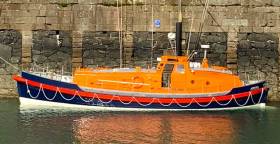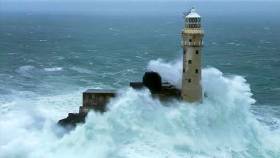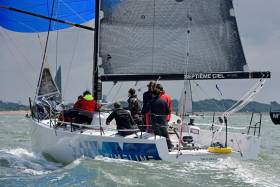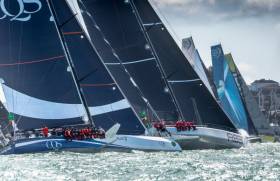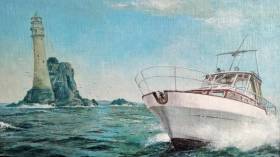Displaying items by tag: Fastnet Race
Fastnet Race 2019 Starts Today in the Solent & Line Honours Leaders Should Be at The Rock Tomorrow Morning
The maritime pageantry which is the sequenced start of the biennial Rolex Fastnet Race gets underway in time-honoured fashion at 12.30 hrs off Cowes today. And in the almost ludicrously varied 390-plus fleet, there are some sailing machines which are so fast they’re said to be the quickest things since the notion of sailing speed was invented writes W M Nixon.
These four specials of the day are the Ultime trimarans from France, which may have first appeared in prototype form in 2017, but since then have been much worked upon, and now they’re 100ft long and look to be damn nearly as wide as that too, while their full speed potential is out of sight.
 The 24-hour Fastnet Race is within her range of possibilities – the 100ft foiling trimaran Macif, skippered by Francoise Gabart, will start the Fastnet Race at 1230 hrs today
The 24-hour Fastnet Race is within her range of possibilities – the 100ft foiling trimaran Macif, skippered by Francoise Gabart, will start the Fastnet Race at 1230 hrs today
Not that most of the competitors will get much chance to see them. They take up so much space they’re not going to berth in Cowes beforehand, but will simply cross the Channel from France, come through the start line at Cowes with their fellow-multihulls first of all classes at 1230, and then after finishing at Plymouth they’ll just head straight back to France without their crews setting foot ashore.
Their magic ingredient – apart from the off-the-wall design and general hugeness in every direction – lies in the fact that they’ve brought offshore foiling technology along to a new level, and if everything holds together, we’re looking at low-flying aircraft rather than high-sailing boats.
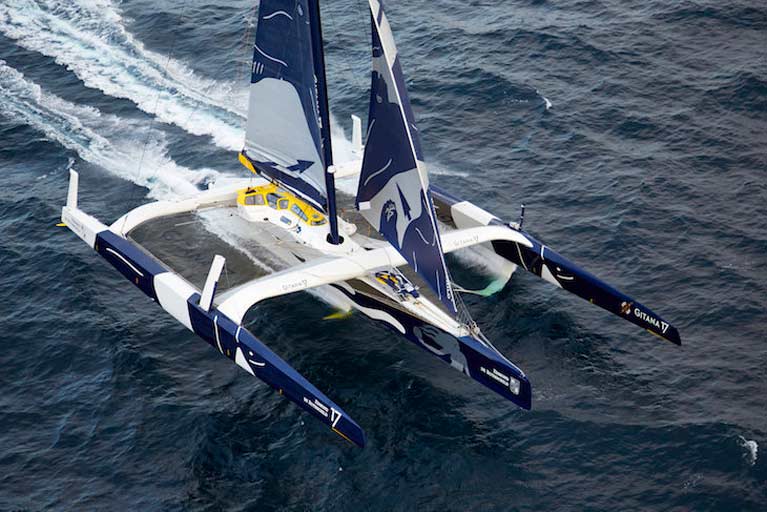 So where would you find the space to park them in Cowes before the Rolex Fastnet Race 2019? The Ultime 32s are leaving their special berths in France directly for the start line in Cowes, then they’ll race round the Fastnet Rock to Plymouth, and then they’ll head straight back to France without their crews setting foot ashore.
So where would you find the space to park them in Cowes before the Rolex Fastnet Race 2019? The Ultime 32s are leaving their special berths in France directly for the start line in Cowes, then they’ll race round the Fastnet Rock to Plymouth, and then they’ll head straight back to France without their crews setting foot ashore.
So much so, in fact, that it isn’t entirely beyond the realms of possibility that - with all the ducks in a row - an Ultime could go round the 608-mile Fastnet course within 24 hours, and it will be between Yves de Blevec’s Actual Leader (now there’s a name to flaunt at the fates), Francois Gabart’s Macif, Franck Cammas & Charles Caudillo’s Maxi Edmond de Rothschild, and Thomas Coville’s Sodebo Ultim 3 to see which of the Ultim 32/23s best does the business.
Certainly they should be at The Rock by tomorrow morning. For although the wind expectations are reasonable for the first 24 hours, with winds tending to be southeasterly in the English Channel and south to southwest beyond Land’s End for the haul across to the Fastnet, there’s a possibility of the breeze going light in the Lizard/Land’s End area. And of course the modern Fastnet course - while still reflecting the race as sailed back at its inauguration in 1925 by the likes of Harry Donegan of Cork with his 17-ton gaff cutter Gull - is now bedevilled by a plague of no-go traffic separation zones at significant headlands, particularly in the Land’s End-Isles of Scilly area where many a Fastnet Race has been won or lost.
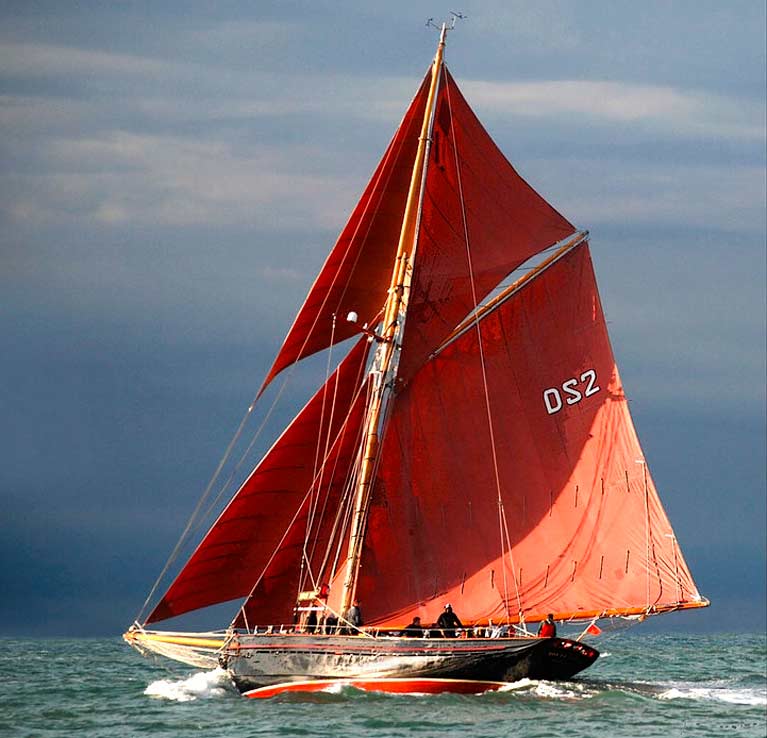 The former French pilot cutter Jolie Brise was the winner of the first Fastnet Race in 1925 when owned by George Martin. When he bought her, the advent of steam-driven pilot boats had made her redundant, and it could be argued that the introduction of the new-style offshore racing was the saving of Jolie Brise. Today, she still sails under the ownership of Dauntsey’s School
The former French pilot cutter Jolie Brise was the winner of the first Fastnet Race in 1925 when owned by George Martin. When he bought her, the advent of steam-driven pilot boats had made her redundant, and it could be argued that the introduction of the new-style offshore racing was the saving of Jolie Brise. Today, she still sails under the ownership of Dauntsey’s School The theoretical basic course of the Fastnet Race reflects its original form, but the modern imposition of no-go Shipping Traffic Separation Zones has made the key area around Land’s End and the Isles of Scilly into even more of an obstacle race than it was already.
The theoretical basic course of the Fastnet Race reflects its original form, but the modern imposition of no-go Shipping Traffic Separation Zones has made the key area around Land’s End and the Isles of Scilly into even more of an obstacle race than it was already.
Time was when all you had to do was avoid hitting the land and the nearest boat and go straight and as fast as you could. But these days you have to work out in advance which side to go on these vast invisible areas of the TSZs, and it has added an enormous tactical extra which affects boats of all sizes.
For instance, in the previous race in 2017, Alex Thomson and Nin O’Leary in the IMOCA 60 Hugo Boss never really recovered from opting to go eastward of the big TSZ running north from Land’s End, whereas Jean-Pierre Dick clung determinedly to a more westerly course despite the IMOCA 60’s reluctance to indulge in a dead beat, and it paid him in spades.
But that was then, this is now, and though there’s an incredible IMOCA 60 entry of 20 boats, it’s those pesky Ultimes which will initially draw all the attention, even if the predicted weather pattern looks to suit the IMOCA 60s much better than the outward windward slug which dominated 2017’s race.
But then, as the froth of the flying machines settles down, we’ll find ourselves concentrating into proper contemplation of the real Rolex Fastnet Race - the hundreds of solid IRC-rated boats which know they’re going to be a sea for more than a day or two, and may well end up experiencing entirely different weather from that of the here today, gone tomorrow giants at the front of the fleet.
For the likelihood is that it’s out of their ranks that the overall winner will appear, even if Actual Leader has gone to the trouble of getting IRC-rated (it’s 2.155, which may mean she’ll almost have to be already finished at Plymouth before some of the smaller boats have passed it while heading west) together with two of the IMOCA 60s (they’re “only” 1.734), all the MOCRA class, and eight of the 22 Class 40s.
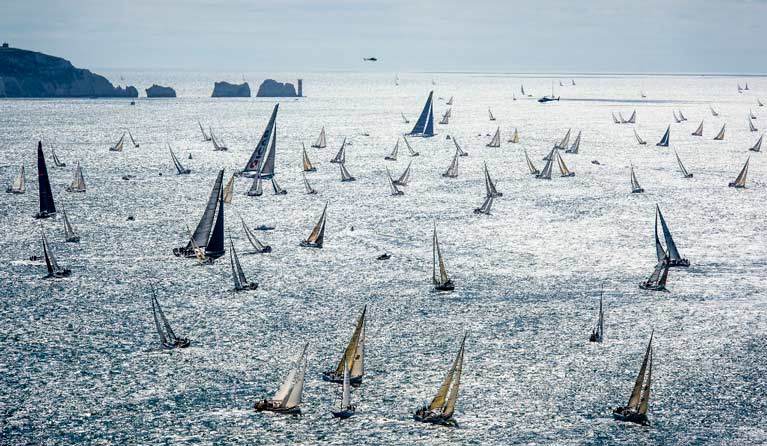 The Fastnet fleet beating towards the Needles as they exit the Solent. The IRC system is remarkably successful at extracting an overall winner from such a diversity of boats. Photo: Rolex
The Fastnet fleet beating towards the Needles as they exit the Solent. The IRC system is remarkably successful at extracting an overall winner from such a diversity of boats. Photo: Rolex
These figures are stratospheric by comparison with the numbers which affect most of the Irish sailors through the fleet, who are to be found on boats from the Emerald Isle, but have also gone international – for instance, Kenneth Rumball of Dun Laoghaire is continuing his successful link-up with the Swedish Ker 40 Keronimo in Class 1, which rates 1.198, 14 points above the 1.186 of Conor Doyle’s Xp 50 Freya from Kinsale, so there’s a duel to watch.
Graham Curran of UK Sailmakers in Crosshaven is taking the vintage route, he’s sailing on the classic S&S-design of 1966, the Swan 36 Finola and they did well in the recent Channel Race. She’s owned by Chris Frost, and they rate way down in the basement at 0.901, which is even lower than the 0.919 of Foynes’ Conor Dillon in the two-handed division in the Dehler 34 Big Deal, and the 1.003 of Kinsale’s Cian McCarthy (also two-handed) in the X362 Eos.
In complete contrast, Conor Fogerty of Howth with his foiling Beneteau Figaro 3 Raw has a punitive rating of 1.124, which puts him into the 63-strong Class 1. The foils on these new boats are a mixed blessing, as Fogerty tells us they only begin to confer any sort of performance benefit when the wind gets up to 15 knots, and it isn’t until 20 knots of wind that you really begin to do the business.
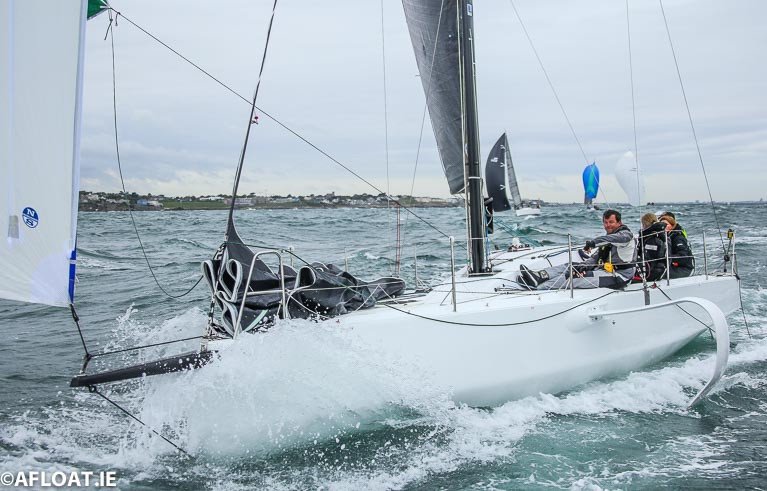 Conor Fogerty’s Beneteau Figaro 3 Raw – she needs 15 knots of wind for the foils to start working effectively and requires it to be hitting 20 knots if she is to sail up to her punitive rating of 1.124. Photo Afloat.ie/David O’Brien
Conor Fogerty’s Beneteau Figaro 3 Raw – she needs 15 knots of wind for the foils to start working effectively and requires it to be hitting 20 knots if she is to sail up to her punitive rating of 1.124. Photo Afloat.ie/David O’Brien
Thus the reality seems to be that the most satisfying boat for a Figaro 3 to race against is another Figaro 3, but although another privately-owned sister-ship was reputedly going to enter, there’s none showing up on the listings, and Raw seems to be on her own, finding that her closest contenders rating-wise in Class 1 include Michael O’Donnell’s J/121 Darkwood, winner of the recent Channel Race, and Andrew Hall’s sister-ship Jackhammer from Pwllheli.
Despite the cards being stacked against him, Conor Fogerty has put together a strong crew of four, as his main helm is Howth’s Laura Dillon who was the first woman to win the All-Ireland championship, together with Figaro racer Joan Mulloy of Mayo, and Corby 25 racer Denis Coleman of Cork.
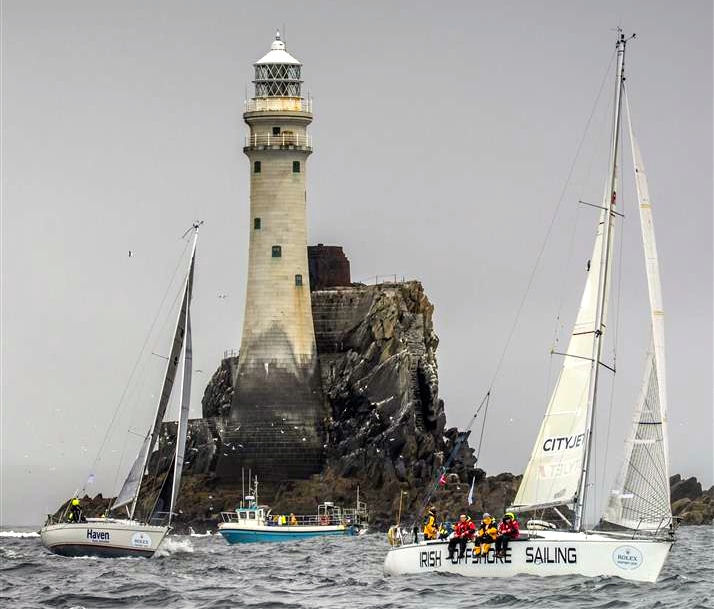 Irish Offshore Sailing’s Desert Star on her way to winning the Roger Justice Trophy in the 2015 Fastnet Race. A regular participant, Desert Star is back this year again under the continuing command of Ronan O Siochru. Photo: Rolex
Irish Offshore Sailing’s Desert Star on her way to winning the Roger Justice Trophy in the 2015 Fastnet Race. A regular participant, Desert Star is back this year again under the continuing command of Ronan O Siochru. Photo: Rolex
It says much about the demographics of modern Ireland that for the past two Fastnets, our most successful boats have come from Offshore Sailing Schools, which have their race within a race for the Roger Justice Trophy. Last time round, it was the Irish National Sailing School’s J/109 Jedi skippered by Kenneth Rumball which took the cup, the time before it was Ronan O Siochru with Irish Offshore Sailing’s Jeanneau 37 Desert Star which is going yet again this year, her crew doubtless inspired by the last time Ireland provided the overall winner, which was in 2007 with Ger O’Rourke’s Cookson 50 Chieftain from Kilrush, an achievement which, in international terms, is right up there with Annalise Murphy’s Silver Medal in the 2016 Olympics.
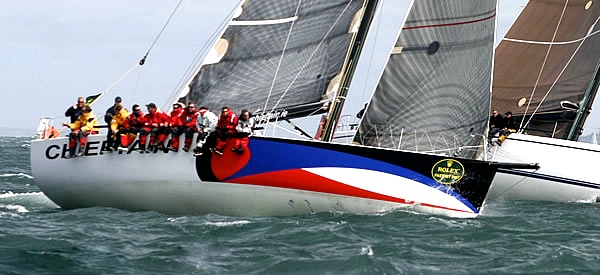 Ger O’Rourke’s Cookson 50 Chieftain from Kilrush at the start of the 2007 Fastnet Race, which she was to win overall
Ger O’Rourke’s Cookson 50 Chieftain from Kilrush at the start of the 2007 Fastnet Race, which she was to win overall
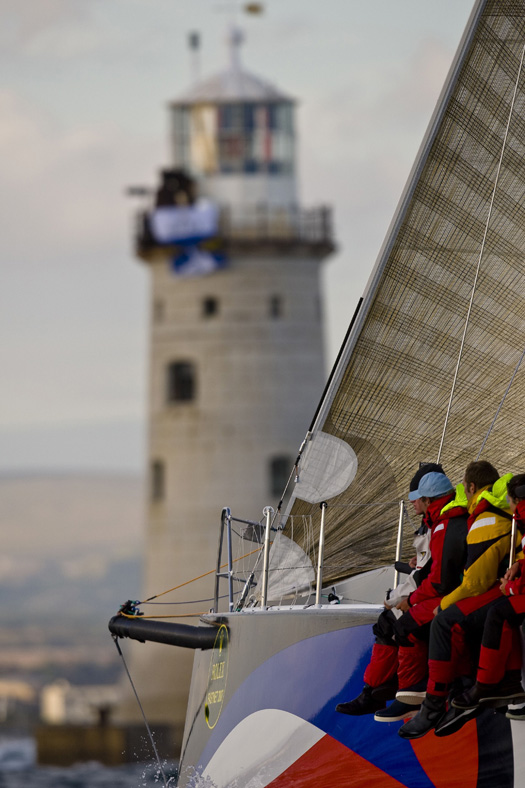 That magic moment – Chieftain at Plymouth Lighthouse, overall winner of the 2007 Rolex Fastnet Race
That magic moment – Chieftain at Plymouth Lighthouse, overall winner of the 2007 Rolex Fastnet Race
With today’s race marking the 40th Anniversary of the history-laden Fastnet Storm of 1979 (even if we are two weeks earlier), there is special interest in boats which were there forty years ago, and none is more remarkable than the vintage Contessa 32 Assent, which was last boat to finish in 1979, but as she was one of the smallest boats in the fleet, she won Class IV for her dogged persistence and heroic performance.
In fact, the Contessa 32’s reputation for ultimate seaworthiness was much enhanced by the Fastnet storm, for with her fairly low freeboard and compact form, she goes into semi-submarine mode when the sea goes crazy. Thus where high volume boats like the then-new OOD 34s (ironically also built by Jeremy Rogers) were being rolled like beach-balls, the Contessa 32 clenched her teeth and went straight through the nasty ones.
Back in 1979, Assent was owned by the Ker family, who are sheep farmers in Somerset, and it was Alan Ker who skippered her in the Fastnet. But after that his father Willie – who of all things had come to sailing through International OK dinghy racing – took over command of Assent, and started a series of ever more adventurous voyages into high latitudes which had won him international recognition and a string of major awards when he finally hung up his seaboots in his 80s.
 The late Willy Ker’s Contessa 32 Assent cruising in Arctic waters 850 miles from the North Pole. Assent won Class IV in the 1979 Fastnet Race sailed by Alan Ker, and she is racing in today’s Fastnet Race sailed by the Rogers family of Lymington, who built Assent and have now given her a major restoration.
The late Willy Ker’s Contessa 32 Assent cruising in Arctic waters 850 miles from the North Pole. Assent won Class IV in the 1979 Fastnet Race sailed by Alan Ker, and she is racing in today’s Fastnet Race sailed by the Rogers family of Lymington, who built Assent and have now given her a major restoration.
By that time Assent was looking distinctly tired, so the Rogers family took her over and brought her back to their yard in Lymington to give her a complete facelift, since when which she has been making her mark back on the racing circuit.
Sadly, the great Willie Ker died last month at the age of 93. But Assent is going stronger than ever, and she’ll be racing today’s Fastnet in a very special capacity in Class IV on a rating of 0.853 (the lowest in the fleet) sailed by Kit and Simon Rogers. So if at some stage during the race you see a very small but accomplished-looking blue boat with sail number GBR 5765, then you’re looking at more sailing history in one little 32ft boat than you’d think possible.
Another piece of remarkable history stepping down the Solent today is American owner Rives Potts’ 48ft Jim McCurdy-designed Carina. Not only was Carina a successful finisher in 1979’s race in her final year of ownership with the great Dick Nye who’d had two overall Fastnet victories back-to-back in 1955-57 with a previous Phil Rhodes-designed Carina, but in fact he’d made his debut with the new alloy-built Carina in the race of 1969. So today Carina is marking both her involvement in 1979, and her Fastnet Golden Jubilee from 1969, while Rives Potts has memories in every direction, as he was a crewmember aboard Ted Turner’s overall winner in 1979’s storm, the 63ft S&S design Tenacious.
If you’re into classic American offshore racers of a certain era and under-stated style, then Carina is the boat for you. She has won at least three Bermuda Races overall, and though she hasn’t had a Fastnet overall victory yet, on her last visit in 2011 she won her class, providing the definitive Fastnet-rounding image just ten hours after George David’s Rambler 100 had lost her keel in very different conditions at the same spot.
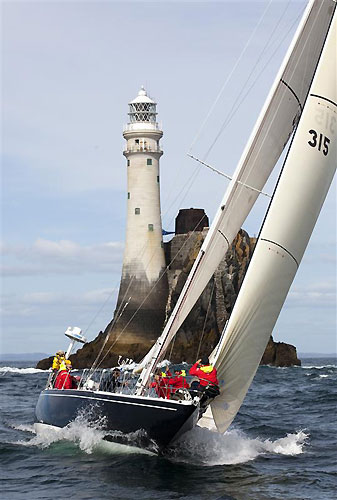 American classic. The Jim McCurdy-designed 48ft Carina (Rives Potts) is a significant presence in the Fastnet Race story. Photo: Rolex
American classic. The Jim McCurdy-designed 48ft Carina (Rives Potts) is a significant presence in the Fastnet Race story. Photo: Rolex
George David is of course back with the all-conquering Rambler 88, and the battle for mono-hull line honours at the front of the fleet is going to be quite something, but maybe he’ll find a minute for a quick salute to his old friends on the Baltimore Lifeboat crew as he rounds The Rock, for it’s possible they’ll be there aboard The Robert, Baltimore’s 1979 Watson 47 lifeboat which has been restored by Jeff Houlgrave.
Out of all this cornucopia of historic and modern boats, an overall IRC winner has to emerge in due course, and for the last three Fastnets, that very special role has been filled by a French boat. So it’s surely time for some other nation to get a look-in, and with dozens of countries sending forth crews, the possibilities are almost endless. But then, waiting and watching to see who finally comes out on top is part of the global fascination that this “Race of Races” attracts.
Race tracker here
Fastnet 40th Anniversary Irish Lightkeeper Attends Memorial Service & Former Baltimore Lifeboat Returns to West Cork
Former Fastnet lighthouse keeper Gerald Butler is due to represent fellow Irish light keepers at a memorial service for 1979 Fastnet Yacht Race on the Isle of Wight this evening writes Lorna Siggins
Former RNLI Baltimore vessel, The Robert, which was one of four Irish lifeboats involved in the Fastnet race rescue, is also returning to the West Cork harbour to remember its role in the Fastnet race rescues.
A total of 19 people, including two sailors with Irish connections, died after storm force 10 winds hit the race 40 years ago next week.
Almost 3,000 competitors and spectators were sailing the 605 nautical mile course from the Isle of Wight to the Fastnet lighthouse and back to Plymouth when conditions changed dramatically on the night of August 13th, 1979.
The ferocity of the storm had not been forecast in time, and there was minimal communication and no satellite technology on the yachts – with even the best equipped unable to deal with 50-60 knot winds.
Among the 132 sailors rescued by Royal Navy and RAF helicopters, RNLI lifeboat crews and the Naval Service ship LÉ Deirdre were competitors on 18 Irish yachts - including a then-winning Irish Admiral’s Cup team.
RNLI Baltimore coxswain Kieran Cotter was a crew member with coxswain Christy Collins onboard The Robert, along with voluntary crews from Ballycotton, Courtmacsherry and Dunmore East lifeboats over a period of 75 hours.
The Robert, a Watson 47 class vessel taken out of service and sold by the RNLI in 1991, was recently retrieved by Glasgow-based businessman Jeff Houlgrave, who restored it and steamed with two crew from Scotland to Crosshaven, Co Cork.
The Robert leaves Crosshaven today (fri) for Baltimore, and will be met by the current lifeboat as it arrives into the harbour.
“The extraordinary men who went out to sea in 1979 had far less equipment than vessels now, and it is the least we can do to save this past heritage,” Mr Houlgrave said.
On the Fastnet lighthouse, Gerald Butler and colleagues Reggie Sugrue and Louis Cronin battled the winds and waves leaping up to the balcony during the 1979 storm to record sail numbers.
They then reported them back to Mizen Head which relayed the information to the race organisers in Cowes.
“I am very honoured to be representing lightkeepers and recognise the role they played in sea safety over several centuries before automation,” Mr Butler said.
Commissioners of Irish Lights deputy commissioner Kieran Crowley has also been invited to the memorial service hosted by the Royal Ocean Racing Club in Cowes on the eve of this year’s Fastnet yacht race start.
Further up the Atlantic seaboard, Clifden, Co Galway, has become the first west coast RNLI station to receive a new Shannon-class lifeboat.
The all-weather Shannon, which was designed by an Irish engineer and is the first RNLI class to be named after an Irish river, was given a warm welcome by several hundred people at Clifden Quay on Wednesday.
Named the Brianne Aldington, the 13-metre Shannon reduces response times to call-outs, as it has a top speed of 25 knots. It replaces the Mersey-class 15 knot vessel at Clifden, and represents a 2.4 million euro investment by the RNLI in the west coast.
The Shannon was designed by Derry man Peter Eyre who as a child was rescued by Lough Swilly RNLI in Donegal. It has an endurance of 250 nautical miles and is powered by waterjets, rather than propellers.
Clifden RNLI coxswain James Mullen recalled how delivering the vessel from RNLI headquarters in Poole, Dorset, was one of his proudest moments.
“ As we rounded Loop Head we hit a bit of weather and we really made her dance,” he said.
There are currently two Shannon-class lifeboats at Lough Swilly in Donegal and Clogherhead, Co Louth, and a relief vessel at the Wicklow station.
Baltimore’s Restored Vintage Lifeboat Will Return to the Scene of the 1979 Fastnet Storm Rescues
It was when the Baltimore Lifeboat was called on the evening of Monday, August 13th 1979 to the assistance of the yacht Regardless that the outside world began to realize that something exceptional was happening to the record 303-boat Fastnet Race fleet writes W M Nixon. With a gathering gale, other yachts were already in difficulties. But as the gale developed into a storm, the call came from Ken Rohan’s Regardless - star boat in the then-winning three-boat Irish Admirals Cup team - that her high-tech carbon fibre rudder stock had broken clean off at sea south of Toe Head.
With one of the most experienced crews of all the boats on board, the fact that Regardless had sought help moved the scenario onto a new level. The Baltimore lifeboat, The Robert, was at sea under Cox’n Christie Collins with a very young Kieran Cotter in her crew, and when she found the disabled Regardless being tossed about like a cork, it took six attempts to get a towline aboard, but after that the fallen star was towed safely into Baltimore, and The Robert put back to sea on other related missions.
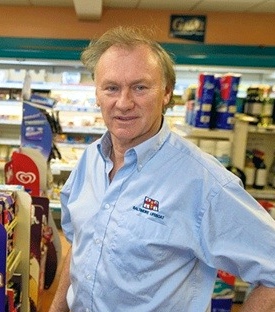 Man of many rescues – the much-decorated Baltimore Lifeboat Cox’n Kieran Cotter at the day job in Baltimore
Man of many rescues – the much-decorated Baltimore Lifeboat Cox’n Kieran Cotter at the day job in Baltimore
Several other lifeboats from along Ireland’s south coast and the boats from St Mary’s in the Isles of Scilly and St Ives on the Cornish mainland, together with helicopters and ships, were also to be involved in the huge rescue effort which saved 132 lives. Yet despite their best efforts, there were to be 19 tragic losses in this exceptional storm, a situation which was to be analysed in several ways – including official reports – in its aftermath.
But gradually life returned to normal, and over the years the recollection of the storm of 1979 has seen the Baltimore Lifeboat, - which had been at sea for longer than any others - becoming the symbol of all the lifeboats involved, a situation which was reinforced when one of her successors, now with Kieran Cotter as Cox’n, played a central role in the rescue of the crew of George David’s super-maxi Rambler 100 when her keel snapped off at the Fastnet Rock in the race of 2011.
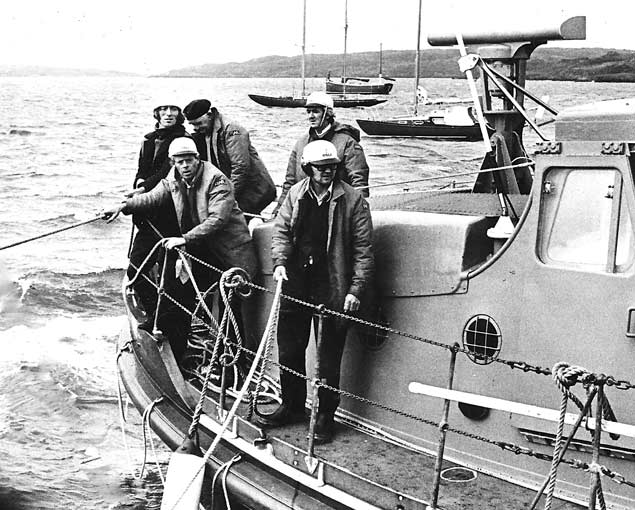 An exhausted Baltimore Lifeboat crew returns to port on completion of their mission in the Fastnet Storm of 1979. They spent the longest time at sea of all the lifeboats on duty in this complex rescue operation
An exhausted Baltimore Lifeboat crew returns to port on completion of their mission in the Fastnet Storm of 1979. They spent the longest time at sea of all the lifeboats on duty in this complex rescue operation
Meanwhile, The Robert, ON 955 and a classic Watson 47, was sliding gently into retirement and obscurity when she was discovered by Jeff Houlgrave. He may be best known on the big boat circuit for his involvement with Marina Projects and as Chairman of Superyacht UK, but one of his intriguing hobbies is the restoration of vintage lifeboats, and with The Robert
he found something very near to his heart.
 The Robert as a cruiser in the early days of her retirement
The Robert as a cruiser in the early days of her retirement
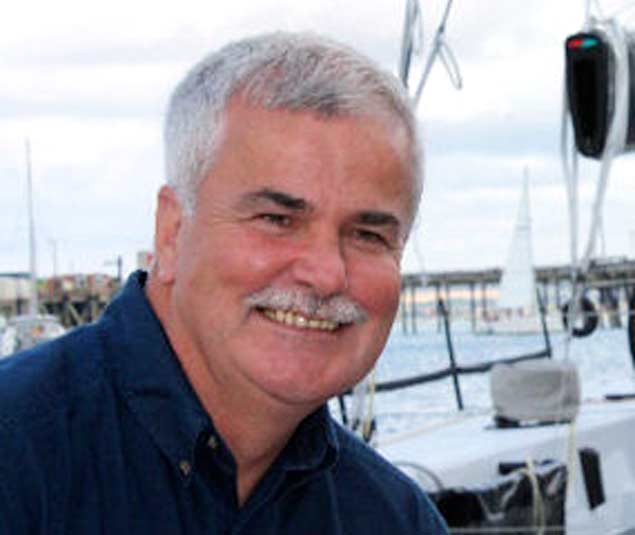 One of Jeff Houlgrave’s individualistic hobbies is the restoration of vintage lifeboats, and The Robert was a very special case
One of Jeff Houlgrave’s individualistic hobbies is the restoration of vintage lifeboats, and The Robert was a very special case
It has to be confessed that when he signalled that this restoration was getting underway last year, the feeling was that time was tight enough to be ready for the big 40th at Baltimore in August. But we were able to put him in touch with Kieran Cotter, still the much-decorated Cox’n of Baltimore Lifeboat, to see what might happen early in August 2019, and last night the signal came through that the superbly restored Robert is now in Crosshaven, and will be heading towards Baltimore on Friday. Clearly, when Jeff Houlgrave gets going on a project, he doesn’t mess about.
With the re-jigging of the international programme such that the Rolex Fastnet Race 2019 start on Saturday 3rd August precedes Cowes Week (10th August – 17th August) for the first time ever, there’s no way any Fastnet racers will be in the region of The Rock on August 13th and 14th, the precise date of the 40th Anniversary of the rescues. But in Baltimore a programme is being developed to reflect the current schedule’s reality while properly respecting the solemn significance of the event.
 Baltimore West Cork – a summer paradise where the links within and between the sailing and lifeboat communities are notably strong. Photo: Tom Vaughan
Baltimore West Cork – a summer paradise where the links within and between the sailing and lifeboat communities are notably strong. Photo: Tom Vaughan
For of all ports, it is Baltimore where the lifeboat crews and the sailing community are most intimately intertwined. Thus in the Beaufort Cup Series within Volvo Cork Week last year, the Lifeboat Service was represented by Baltimore with Deputy Cox’n Youen Jacob skippering their J/109 to such good effect that at times they were leading the very competitive fleet, and at the end it was so close that the theoretical winner, Commandant Barry Byrne with the Defence Forces crew on John Maybury’s J/109 Joker 2, reckoned that as he and his crew were given the choice of which charity their €10,000 prize should go to, they should divide it between the Children’s Hospital and Irish Lifeboats. That’s the way it is in Baltimore.
This weekend forty years ago, I was the chirpy co-skipper of the smallest boat in the Cruise-in-Company fleet as we closed in on Glengarriff in far West Cork for the Golden Jubilee party of the Irish Cruising Club in the magic place where it had been founded in July 1929 writes WM Nixon.
There were boats from several organisations including the Cruising Club of America which were on a busy schedule, as several of them - and some of the Irish Cruising Club fleet too - planned to head on soon in order to do Cowes Week and the 1979 Fastnet Race, for in those days many cruiser-racers really were cruiser-racers.
 …..and the Fastnet Rock in an entirely different mood. Photo: Rolex
…..and the Fastnet Rock in an entirely different mood. Photo: Rolex
Our “smallest boat in the fleet” was the cat ketch Endeavour, prototype of the lift-keel 21ft Poacher developed by Willie and Angus Richardson of Liverpool and Holyhead. During a test sail in June from Holyhead which took us round to Treardur Bay and all the delights thereof, the idea arose that Endeavour would be just the job for participation in the ICC’s celebratory cruise-in-company. My own boat at the time was a Squib, which wouldn’t quite do for a week-long cruise from Crosshaven to Glengarriff, whereas Willie was mad keen to show his new mini wonder-cruiser to as many people as possible.
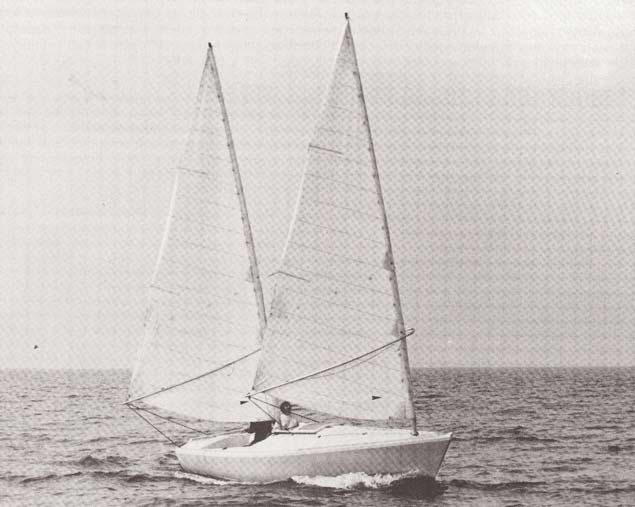 The Poacher 21 cat ketch Endeavour was the smallest boat in the ICC Golden Jubilee fleet of July 1979, but by no means the slowest. Photo: W M Nixon
The Poacher 21 cat ketch Endeavour was the smallest boat in the ICC Golden Jubilee fleet of July 1979, but by no means the slowest. Photo: W M Nixon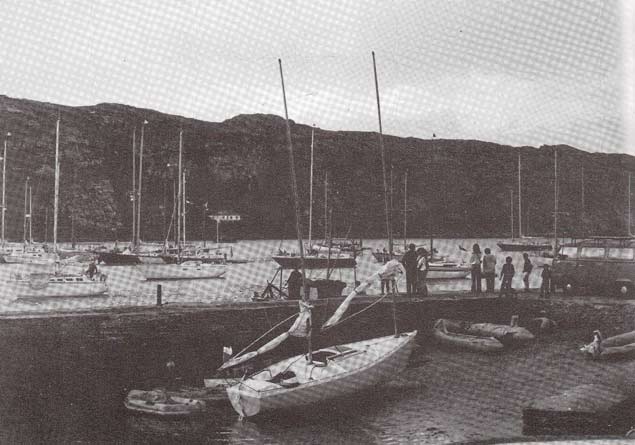 So who needs a dinghy? Endeavour at Crookhaven, with some of the Cruise-in-Company fleet moored off. Photo: W M Nixon
So who needs a dinghy? Endeavour at Crookhaven, with some of the Cruise-in-Company fleet moored off. Photo: W M Nixon
The charter fee may well have been a shilling or whatever currency we used at the time, but though modest it made our participation official, while the time economy of being able to road-trail the boat to Crosser and then trail her back again from Glengarriff suited a hyper-busy season.
For those were the glory days of the Admirals Cup, the Irish were very much to the fore, and Nixon Verbiage Industries plc were on treble overtime to keep up with everything and feed several hungry printed news outlets.
Yet as we took our farewell of friends from both sides of the Atlantic and headed up the long road from Glengarriff back to Dublin, the mood was typical of this busy though somehow also soporific mid to late summer sailing time as August approaches, with a definite shift of emphasis. Not that we’d the faintest notion that within a fortnight the fiercest storm ever to strike the Fastnet Race fleet would be gathering power to obliterate the languid weather still lingering from July. On the contrary, it was because this is the way it is with the pattern of our sailing summer.
For this is the time in the Irish sailing year when leading figures undergo something of a character change. Not quite Jekyll & Hyde, admittedly. But nevertheless with the shift of emphasis moving towards the August mood, we find those who have been at the coalface of event administration gradually re-emerge as racing participants in events elsewhere, while with others the movement is in the opposite direction.
Thus today is the final day of the WIORA Championship in Foynes, with Alan Crosbie of Kinsale as ever the Race Officer. But he and his specialists will be relying on a team of local volunteers many of whom will reappear next week as Mermaid sailors in the first-ever Mermaid National Championship to be staged by the Royal Cork YC at Crosshaven. It has all the makings of a very special event, for the Mermaids are among the most popular classes for hosting clubs – Mermaid sailors are fully aware of their duties as enthusiastic consumers – while the class is on a roll at its several centres, with new and restored boats continually augmenting the fleet.
But even as we contemplate the special interest in events in Cork Harbour, inevitably next Friday our thoughts will also be in Cowes, and the Memorial Service for those 19 people lost in the 1979 Fastnet Race tragedy. Forty years on, the freakish nature of that brief-lived but hyper-violent August storm has taken on its own mythology. But there’s no escaping the ultimate reality, and some quiet reflection next Friday is only right and proper before the huge Rolex Fastnet Race fleet sweeps westward down the Solent next day in one of world sailing’s greatest acts of waterborne choreography.
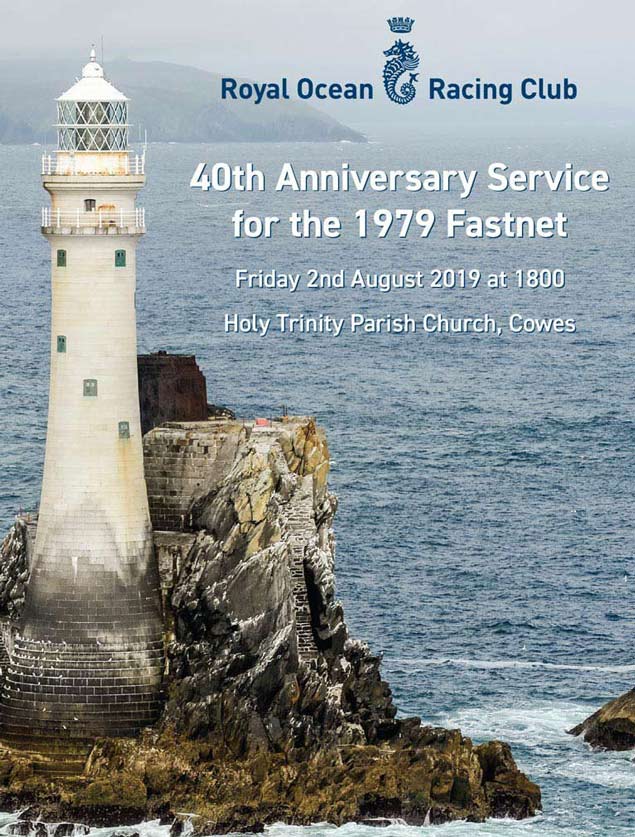 The notice for next Friday’s Fastnet Memorial Service shows The Rock with Cape Clear in the background
The notice for next Friday’s Fastnet Memorial Service shows The Rock with Cape Clear in the background The Memorial Stone on Cape Clear
The Memorial Stone on Cape Clear
Back in 1979, it was the biggest fleet yet seen – 303 boats - but even the most experienced sailors were almost overwhelmed by their experience of the storm between August 13th and 14th. For sure, you expect the occasional gale. But this was much more than a gale.
It had so happened that during the dreamy Cruise-in-Company towards Glengarriff in July, at a couple of stopovers our little boat was berthed next to the American Swan 47 Toscana owned by Eric Swenson, who had Cowes Week and the Fastnet Race next up on his programme.
We were impressed by the owner’s determination to make the use of his fine boat as comprehensive as possible, and for the Fastnet, one of the crew was to be the noted American sailing writer John Rousmaniere. He found himself in the midst of history in the making, and his very timely book Fastnet Force 10 continues to be the definitive account of the storm and its effect, even in the face of subsequent official reports and other more personal stories.
Meanwhile, having notched a trio of Fastnets, I was more involved in parenthood in 1979, but had somehow worked it to fit in a brief family holiday in Cornwall with the In-Laws while still contriving to be up in Plymouth on the Thursday when we had anticipated reporting the Irish Admirals Cup triumph. Instead, I found myself being given an extremely personal account of the Fastnet Storm 1979 by overall winner Ted Turner in a corner of the bar in the Post House Hotel. But for reasons of State Security, the outcome of that conversation is under wraps under the Official Secrets Act until at least 2029, and probably later.
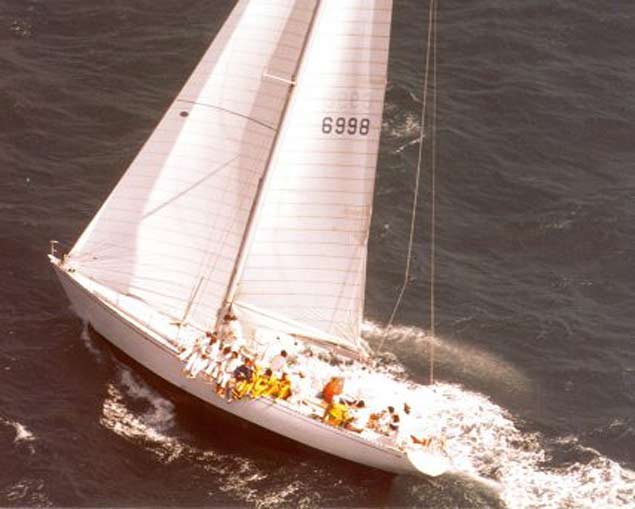 Ted Turner’s 63ft S&S design Tenacious, overall winner of the 1979 Fastnet Race
Ted Turner’s 63ft S&S design Tenacious, overall winner of the 1979 Fastnet Race
However, one of the best accounts of experiencing the Fastnet Storm is found in designer Ron Holland’s “All The Oceans”, the monumental but fascinating Memoir he published last year. The sheer variety and achievement of the talented New Zealander’s roller-coaster life is shown by the fact that the storm, which directly affected a significant number of his most successful boats at the sharpest end of the Fastnet fleet, is just another episode in a career in which he was based in Ireland for forty years - in Currabinny and then Kinsale - while creating a global design practice.
That said, the storm had a profound effect on him as it had on everyone else who came through it, and his account of experiencing it aboard Hugh Coveney’s 43ft Golden Apple of the Sun – which he had of course designed, while Killian Bushe in Cork was the builder – is one of raw candour.
Golden Apple was the senior member of the Irish Admiral’s Cup team – the other two were 39 footers, Ken Rohan’s Regardless which Holland had also designed, and the Peterson-designed Rogers 39 Inishanier (Barry Bramwell & Brian Buchanan) – and the team had gone into the Fastnet Race at the end of Cowes Week well ahead in the Admirals Cup points table, with Regardless the top scoring boat.
 Ken Rohan’s Regardless (RIYC) racing in the Admirals Cup in the Solent in 1979. Going into the Fastnet Race, the Ron Holland-designed Regardless was the top-scoring boat in the AC, while Ireland was the leading team.
Ken Rohan’s Regardless (RIYC) racing in the Admirals Cup in the Solent in 1979. Going into the Fastnet Race, the Ron Holland-designed Regardless was the top-scoring boat in the AC, while Ireland was the leading team. The Fastnet Race course
The Fastnet Race course
With the Fastnet Race scoring extra points, things were looking good for all the team on the second night out as they approached The Rock, but by the time the storm had gone through completely, only Inishanier was still racing. Regardless had been an early faller when her carbon-fibre rudder stock broke off at The Stags at Toe Head, and she was saved by the Baltimore Lifeboat. But Golden Apple, having rounded the rock, was still very well placed while heading for the next turn at The Bishop Rock. Ron Holland’s account well captures the way it was that night and into the next day. He takes up the story as darkness draws on and Golden Apple, with himself on the helm, is slugging into winds already gusting well above 40 knots, approaching The Rock on port tack:
“The image of The Rock that evening is burned into my memory. As we bore down on it the lighthouse keepers switched on the beam, sending a ghostly wagon wheel of yellow spokes across the white water. I steered directly for the lighthouse, estimating that the yacht’s leeway would push us clear of the turmoil before we prepared for the rounding. Since I was on the helm, it was my call and I had made a decision.
Big as the seas were, I was determined to take Golden Apple as close as I dared and slip inside the few other yachts that were lying just ahead, their stern lights coming and going in the breaking waves. I had noticed that though they were much bigger than us, they were standing further out to sea and giving The Rock a wider berth. I knew what I was doing, or at least I hoped I did. Familiar as I was with these waters, I had never before rounded The Rock in a full gale.
 Ron Holland today. In a design career spanning more than 50 years, he has worked his way through many commissions from Quarter Tonners and even smaller craft to some of the world’s largest superyachts
Ron Holland today. In a design career spanning more than 50 years, he has worked his way through many commissions from Quarter Tonners and even smaller craft to some of the world’s largest superyachts
Keeping the lighthouse to port, I steered for the white water. I caught a few concerned glances from the crew as the yacht hit violent cross-currents from the waves smashing back from the rocks, and began to buck and heave like a bronco. I gripped the wheel as hard as I could, and others clung to any handhold they could find.
Judging the moment, I yelled “Ready about”, and threw the wheel over, flipping Golden Apple onto starboard tack for the rounding. The crew scrambled up to the starboard side and prepared to ease the sheets as soon as we cleared The Rock and the lighthouse. I glanced under the boom and saw for the first time the space between us and The Rock. All of a sudden it seemed a little too close for comfort.
On her new tack, the yacht took a few seconds – too many seconds – to get back up to speed. The helm felt soft as the rudder struggled to bite in the foam and froth. Glancing back, I could see a black trail that out passage had carved into the whiteness. I was struck by a fleeting through that the other yachts outside us were probably watching and wondering if we had taken leave of our senses.
Eventually, Golden Apple picked herself up, and although thrown about like a toy, began to plough her way through the turmoil. “That was a bit scary”, I thought.
A soon as we were clear of The Rock, we set a course for the Scilly Isles……Looking back in the gathering darkness, I could make out the other yachts far behind us. “We just killed those guys” I yelled. And I was right. Later we would learn that the lighthouse keeper had recorded us as leading the race on corrected time.
 Poetry in sailing……Golden Apple of the Sun’s famous transom
Poetry in sailing……Golden Apple of the Sun’s famous transom
Tired from my stint on the helm, I handed the wheel over to Harry Cudmore for his one-hour trick: it was impossible to concentrate longer than that…………. Golden Apple tore into the night like a scalded cat.
Right through the darkness, there was no let-up from the conditions, and at dawn, the wind was still screaming with gusts shrieking through the rigging at 60 knots or more…..I had never seen seas like these……They marched over the horizon, white water tumbling over the top as though they were breaking on a beach….throwing Golden Apple around like a rag doll. Line after relentless line they stretched……There was no reprieve.
Steering Golden Apple had become a gamble with disaster…..you’d to treat the boat as though she were a 15-ton surfboard. You’d to angle her down the wave so she didn’t bury her nose in the bottom of the trough, or she might somersault stern over bow…when a yacht pitchpoles, anything can happen…..
When I’d finished my latest turn on the helm I went below, not to sleep because that was out of the question, but just to lie down, even if my head was resting on a soaking wet pillow. My back and arms were aching from two days and nights of turns on the wheel. And I was sore and bruised from a fall. It had happened while I was relieving myself over the side while clinging to the backstay – the standard procedure – when somebody yelled: “Breaking wave!” “Jeez, it must be a big one”, I thought. “Aren’t they all breaking?” And then it hit, knocking me clean off my feet. If it hadn’t been for my crewmate Neil Kenefick, it would have been worse. Reacting fast, he grabbed me and threw me unceremoniously to safety in the bottom of the water-filled cockpit.”
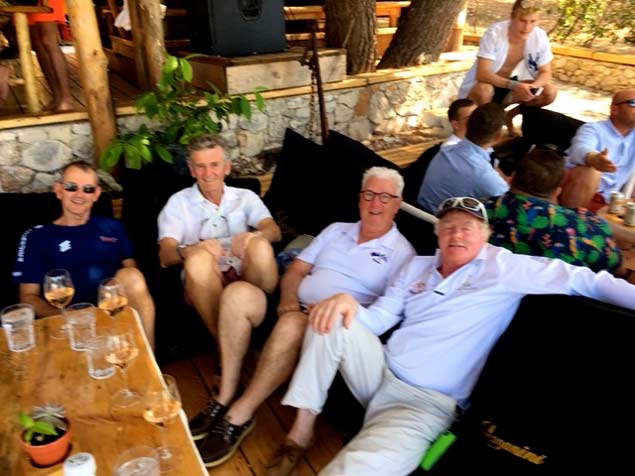 Forty years down the line – Ron Holland and his saviour Neil Kenefick (right) relaxing with two shipmates during a cruise in Croatia earlier this month. Photo: Harold Cudmore
Forty years down the line – Ron Holland and his saviour Neil Kenefick (right) relaxing with two shipmates during a cruise in Croatia earlier this month. Photo: Harold Cudmore
Golden Apple was moving fast and staying with the storm, and all the time the sea was becoming even more rough and confused. The noise below was unbelievable. Ron persuaded his shipmates that they had to slow the boat back and for a couple of hours they were under a lone storm staysail. Then at last conditions began to ease, and they were soon in full racing mode again, albeit still heavily reefed.
Ron continues: “Taking another turn on the helm, I kept a wary eye astern for a rogue wave, the one that can so easily catch you by surprise. Although we might be over the worst of the storm, the seas remained monstrous. I’d not been long on the helm when somebody shouted above the screaming of the wind: “Big wave coming!” It had become a familiar warning but I remember thinking once again: “Jesus, this must be a beauty”.
Crash! A wall of white, grey and turquoise water – I still remember the colours – broke over us and knocked Golden Apple straight onto her beam ends. I wrenched the wheel hard to stop her broaching and lying side-on to these huge waves, a dangerous position for boat and crew. In my anxiety, I must have overdone it. Above the din of wind and waves, I heard a loud bang. With a sinking feeling, I immediately knew what had happened. The carbon fibre rudder shaft had snapped. Confirming my fears, the wheel went limp in my hands”.
Golden Apple’s race was over, but by this time a massive rescue operation was underway through much of the fleet, and as they’d got so far on their way to the Scillies, it was a Cornwall-based SAR helicopter which came by and gave her crew the difficult decision to accept crew retrieval as they struggled with limited success to implement emergency steering. Owner Hugh Coveney, like his shipmates, was game to struggle on. But the SAR pilot gave him a take-it-or-leave-it option, while warning of a new gale approaching to sweep them in among the maze of rocks which make up the Isles of Scilly. So crew safety became paramount and they were soon brought ashore, with Hugh Coveney the last to be lifted into the helicopter.
 The SAR Helicopter crews were hyper-busy throughout the emergency
The SAR Helicopter crews were hyper-busy throughout the emergency
Compared to the fatal outcomes which several boats experienced, the situation of Golden Apple’s crew served instead to emphasise the extremity of the weather. This was one of the most accomplished crews in the entire fleet. Yet even they had never experienced anything like it.
But despite their brutal choice with the helicopter overhead, Golden Apple drifted clear of the rocks of the Isle of Scilly. Eventually, she was brought in to Hughtown in the Scillies by a fishing boat. Since then, it’s believed new owners have taken her on a round the world cruise.
Fastnet Race: Passion & Power In IRC Three & Four
For the previous four editions of the Rolex Fastnet Race, the elation of overall victory has been enjoyed by a team racing a yacht of less than 40ft. In the 2013 and 2015 editions of the 605-nautical-mile offshore race, the top three boats overall came from IRC Three and Four.
This year, currently 340 teams will race under IRC for the overall win and over half of them will be competing in IRC Three and Four. The vast majority of the 3,000-strong competitors in the 400-boat fleet are passionate amateurs, racing on a huge variety of boats, with 88 different designs found in these two classes.
Eighty-five yachts have entered IRC Three: 46 from Great Britain, 18 from France and also Belgium, Germany, Ireland, the Netherlands, Poland, Russia, Switzerland, and the USA.
Twelve JPKs will be competing in IRC Three this year, including their designer Jean-Pierre Kelbert, racing JPK 10.30 Léon Two-Handed, with Alexis Loison.
JPK designs have an impressive track record, winning IRC Three for the last three editions of the race, and the race overall in 2013 (Pascal and Alexis Loison, JPK 10.10 Night and Day). In 2017, the class went to the wire, with Arnaud Delamare and Eric Mordret’s JPK 10.80 Dream Pearls winning by just 71 seconds from Marc Alperovitch’s JPK 10.80 Timeline. Alperovitch had previously won class in 2009, while taking fourth in 2013, as well as second in 2017. Both teams will be back this year, with Timeline now in two handed mode.
“We reckoned that there were 10 boats in a position to win and that included five British boats,” says Timeline’s owner Alperovitch about the 2017 race. “There was always a competitive boat next to us, it is quite strange to be in the middle of the Celtic Sea and be racing as if it were ‘round the cans’, except it took roughly half a day to overtake another boat!”
Eight Sun Fast 3600s will be in action, including two British teams in top form: Trevor Middleton’s fully crewed Black Sheep and Rob Craigie’s Bellino, racing two handed with Deb Fish.
The Rolex Fastnet Race is likely to decide who will be in pole position overall for the 2019 RORC Season’s Championship. Four of the Black Sheep crew met on the Clipper Round the World Race and this will be Middleton’s third race in succession.
“We are not thinking about the overall win, just to put in our best performance for the race,” explained Middleton. “The competition in our class is really tough, but if I was to single out one area in respect of Bellino, it is that they run symmetric spinnakers to our asymmetric, so a tight reach back from the Rock would be just fine for Black Sheep.”
 Trevor Middleton’s Sun Fast 3600 Black Sheep | Photo: Tim Wright
Trevor Middleton’s Sun Fast 3600 Black Sheep | Photo: Tim Wright
Eighty-nine yachts have entered IRC Four: 52 from Great Britain, 16 from France and also entries from Belgium, Ireland, the Netherlands, and the USA.
Noel Racine’s Foggy Dew is one of 11 JPK 10.10s racing in the class. Racing his former JPK 9.60 and his current charge, Racine has an impressive record in the Rolex Fastnet Race. Taking part in all seven editions since 2005, Racine has won his class three times and placed third and second respectively in the last two races. In this year’s 179-boat Cowes-Dinard-St Malo Race, Francois Moriceau’s JPK 10.10 Mary was the class winner and second overall.
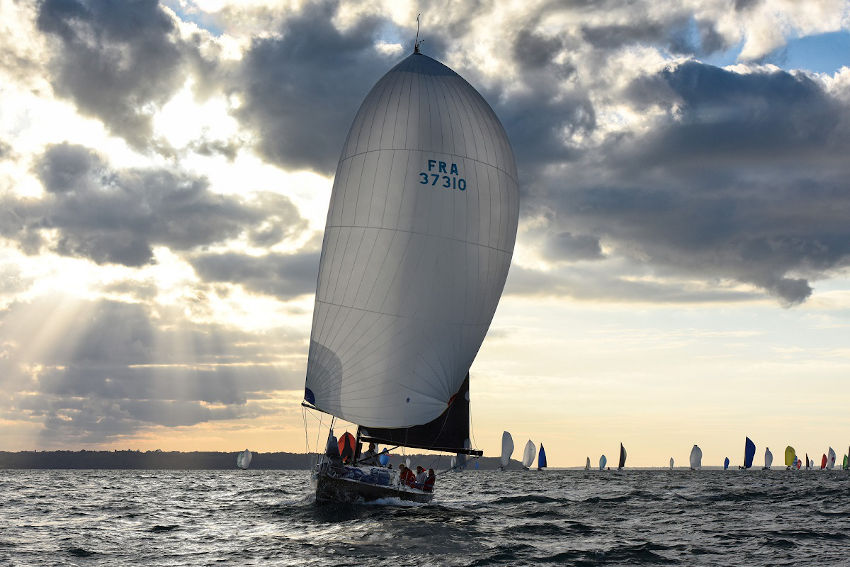 Noel Racine’s Foggy Dew | Photo: Rick Tomlinson
Noel Racine’s Foggy Dew | Photo: Rick Tomlinson
Designed in 1985 by David Thomas in collaboration with the RORC and the Royal Thames YC, and built in Plymouth, Seven Sigma 38s have entered IRC 4. The one-design sloop was built to stand up to tough offshore conditions using data from the tragic 1979 Fastnet Race.
Chris and Vanessa Choules’ With Alacrity is the leading Sigma 38 for the 2019 RORC season. Since 2009, With Alacrity has completed all five editions of the Rolex Fastnet Race, finishing in the top three Sigma 38s every year, before finally winning in 2017.
“We have owned With Alacrity for 15 years and having done a transatlantic, we got hooked on the racing, particularly the competitive racing against other Sigma 38s. The Rolex Fastnet Race is the longest race we can realistically do, and we aim to get around safely and with a happy crew,” explained Chris Choules.
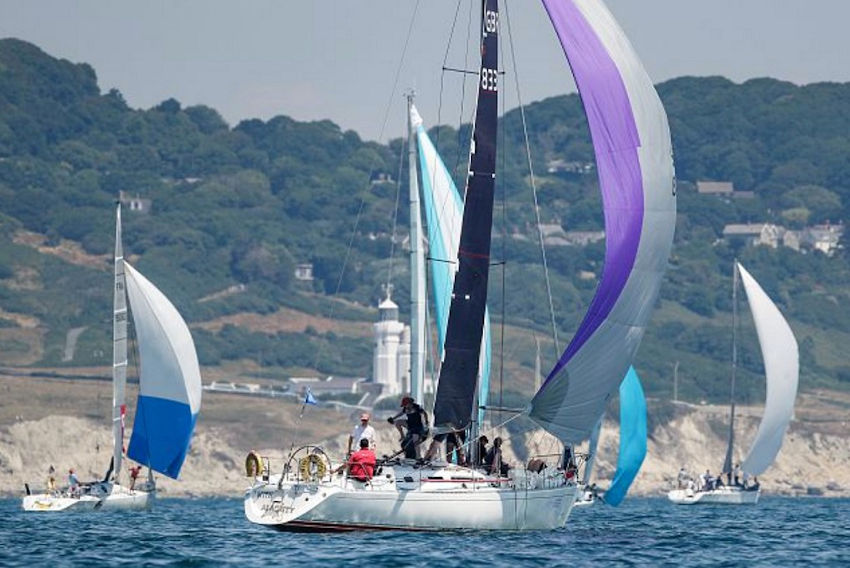 Sigma 38 With Alacrity | Photo: Paul Wyeth
Sigma 38 With Alacrity | Photo: Paul Wyeth
Sixteen J/109s will be competing in IRC Three and IRC Four. The 35ft bowsprit design has its own prize, the J/109 RORC Trophy. The leading J/109 for the RORC season is David McGough’s Just So, overall winner of the 2019 Morgan Cup with 85 teams racing under IRC. Just So won the J/109 RORC Trophy in the 2015 Rolex Fastnet Race.
The British Armed Forces have a long history in the race and this year, four teams from Her Majesty’s Armed Forces will be racing in the J/109 fleet. The RAF with Red Arrow, the Royal Naval with Jolly Jack Tar, the Royal Engineers with Trojan, and the Royal Armoured Corps with Ajax.
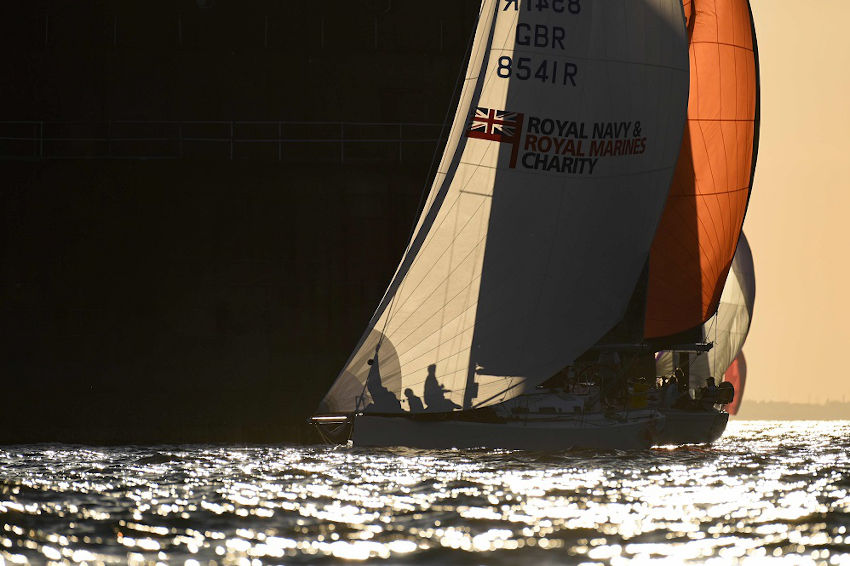 Jolly Jack Tar | Photo: Rick Tomlinson
Jolly Jack Tar | Photo: Rick Tomlinson
Jolly Jack Tar’s skipper Lt Tom Thicknesse RN started yacht racing with the Royal Navy; this will be his second race, and first as skipper.
“Whatever the weather, we are expecting a mentally and physically draining race that demands everything from the crew. We have our sights set on the Inter-Regimental Trophy for the best service yacht and aim to be in the top five J109s overall,” says Thicknesse.
“Offshore sailing has been a key element of Royal Navy sport and adventurous training for many years as the mental and physical challenge gives the opportunity to develop the endurance, leadership, teamwork and courage of our crew. The race epitomises this challenge.”
Classic yachts abound in IRC Three and Four, including 17 Nautor’s Swans and four more classics from the drawing board of Sparkman & Stephens. These majestic yachts with beautiful lines will also race for the S&S Trophy.
All of the classics competing in the 48th biennial Rolex Fastnet Race will be eligible for a new trophy donated in 2017 by Matt Brooks and Pam Rorke Levy, owners of the S&S yawl Dorade, winner of the Fastnet Race in 1931 and 1933.
Former Commodore of the New York Yacht Club, Rives Potts will race his McCurdy Rhodes 48 Carina having crossed ‘the pond’ with the 2019 Transatlantic Race this summer. Potts’ connection with the race goes back to the infamous 1979 Fastnet Race which he won as crew on media mogul Ted Turner’s Tenacious.
The oldest boat in the race this year is Paul Moxon’s 1939 Amokura. The Shepherd-designed classic yawl was built as ‘a speedy vessel, suitable for both cruising and ocean racing’ and designed for Major Ernest Harston, ADC to Lord Mountbatten. She will be joined in IRC Four by Sir Francis Chichester’s famed 53ft ketch, Gipsy Moth IV which is run as a charity to maintain her sailing heritage.
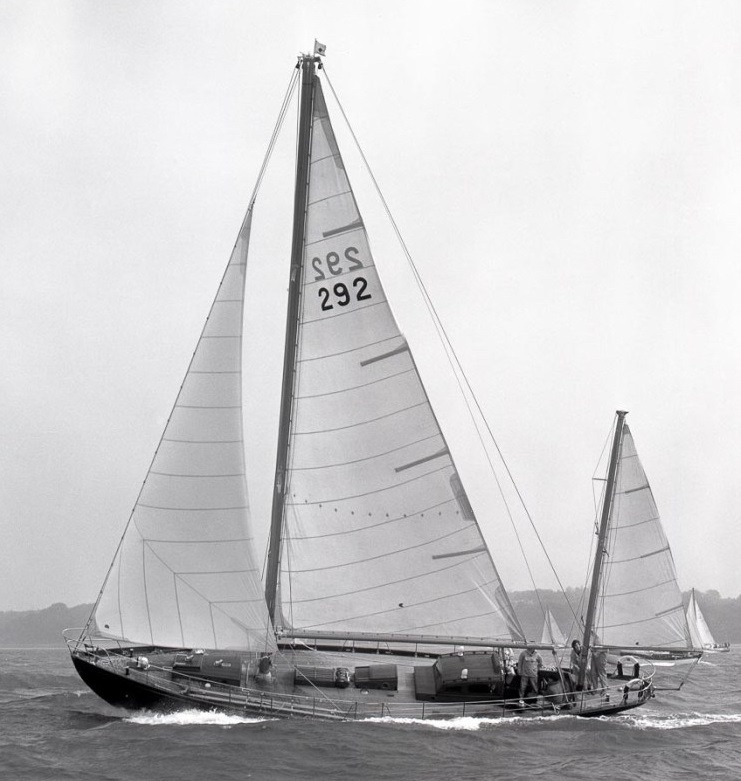 Paul Moxon’s 1939 Shepherd-designed classic yawl Amokura | Photo: Beken
Paul Moxon’s 1939 Shepherd-designed classic yawl Amokura | Photo: Beken
Another classic yacht with a strong connection to the 1979 race is the Contessa 32 Assent, which was originally named Tessa of Worth and the only yacht in Class 5 to complete the 1979 Fastnet Race. Assent, which has the shortest waterline length (24ft) in the 2019 Rolex Fastnet Race, is now owned by Kit Rogers and skippered by Simon Rogers. Their Father Jeremy Rogers set up Contessa Yachts in 1961.
“This is a pilgrimage to show respect for the ’79 race, now 40 years ago,” commented Simon Rogers. “Our crew will be my oldest child Hattie, and Kit’s oldest Jonah, who are both 19, and this will be in their first Fastnet.”
Fastnet Race: Big Boat Prospects
The weather will play a significant outcome in determining the overall results of the Rolex Fastnet Race. Winning your division is more within each team's control, and here we'll look at the top three IRC handicap categories in terms of size and speed. IRC Zero is where the biggest boats congregate and is likely to produce the monohull line honours winner. However, you have to go back to the 2009 and 2011 editions of the race to find the last Maxi to win overall - on both occasions the impeccably sailed Rán 2.
IRC One produced the last edition's winner in 2017, and Lann Ael 2 is back to defend her title, although victory in this hard-fought division will be no picnic for the French crew. IRC Two is also capable of delivering an overall winner, and it is here where the 2015 winner Géry Trentesaux is returning with his new boat, Courrier Recommandé.
Let's take a look at some of the runners and riders, and speculate on who might emerge victorious in 2019
IRC Zero
The biggest boat in IRC Zero is the 100-footer Sun Hung Kai/Scallywag 100, owned by Seng Huang Lee from Hong Kong. The international crew is led by experienced Australian sailor David Witt, former 18ft skiff sailor and skipper of the Scallywag team in last year's Volvo Ocean Race. She will be relying on a windy start and light airs conclusion to have a chance at winning on handicap.
 George David's American Rambler 88 Photo: Rick Tomlinson
George David's American Rambler 88 Photo: Rick Tomlinson
Closest rival in terms of speed through the water is Rambler 88, George David's canting-keeled sloop from New York. The 88-footer has clocked up some impressive results which include overall winner of Les Voiles de St Barth, line honours winner of the RORC Caribbean 600 and the Rolex Middle Sea Race, as well as third on the water in the Rolex Sydney Hobart. Rambler 88 also took monohull line honours in the 2017 Rolex Fastnet Race, so has the raw speed, thanks to an experienced crew that numbers many of the America's Cup winning Alinghi crew in its ranks, not least former Alinghi skipper Brad Butterworth. This will be David's fifth time of competing, and the ambitious owner still hankers for the overall win: "Too often we have been bridesmaid, which could be what brings us back - along with the great traditions and scenery of this classic race."
Expect to see a tough battle between the Maxi 72s Lucky and Sorcha (formerly the two-time Fastnet winner Rán 2) along with Jethou which was extended over the winter from a 72-footer to 77ft. Lucky was previously the Maxi 72 World Champion Bella Mente now in the hands of American owner Bryon Ehrhart, following in the footsteps of his 63ft Reichel Pugh design and before that the TP52 in which he scored a series of strong results. Lucky has already demonstrated her class with some strong performances in the Mediterranean including Capri Sailing Week, the Rolex Giraglia Race, Palermo to Monaco and the Maxi Worlds. Ehrhart has twice competed in the Fastnet, so knows some of the pitfalls along the way, not least from running aground on the Shingles bank not long after the 2015 start, which forced his RP63 out of the race. No wonder then that Ehrhart identifies the start as one of the most critical parts of the course, where he believes the key to success will be "picking lanes through smaller, slower boats in restricted waters. We'll aim to sail safe, sail hard and sail fast."
Quite a few ex-Volvo Ocean Race boats show up in this division, with Volvo 60s, 65s and 70s all hoping for some fast downwind sailing to make the most of their round-the-world design pedigree. Perhaps the most competitive of these is the VO70 Wizard, formerly Franck Cammas' 2011-12 Volvo Ocean Race winner Groupama 4, now owned by Baltimore brothers, David and Peter Askew. Recent winner of the Transatlantic Race 2019, Wizard keeps on clocking up significant victories, notably the RORC Caribbean 600, Chicago Mackinac, Bayview Mackinac and Newport - Bermuda Race, along with a class win at the Rolex Sydney Hobart Race. Not so surprising when you learn that the team includes a couple of Volvo Ocean Race veterans - former winner Rob Greenhalgh from the UK, two-time skipper Charlie Enright of the USA and Australian navigator Will Oxley.
Further down the size range are a bunch of competitive 50-something-footers, including David Collins' Botin IRC52 Tala (formerly Interlodge and Spookie) which recently claimed line honours victory in the Royal Ocean Racing Club's Myth of Malham race. Tala will enjoy a good battle with Outsider, a purpose-built offshore TP52. Expect a tight fight between five Cookson 50s, including the Italian team Endlessgame owned by Pietro Moschini, which includes past America's Cup helmsman Paolo Cian in the crew. Watch out for Ron O'Hanley's Privateer as the pick of the bunch after finishing runner-up to Lann Ael 2 in the overall standings for the 2017 Rolex Fastnet Race.
A couple of other boats in this size range are Oystercatcher XXXIII, owned by east-coast racing veteran, Richard Matthews, who this year will be celebrating his 23rd Fastnet Race, and exactly 50 years since he and fellow crew member, Alan Brooke, first raced around the lighthouse. Oystercatcher XXXIII is a Ker 51 which was previously campaigned by Dutch race veteran Piet Vroon, best known for his series of Tonnerre yachts. Among the crew is the 470 Olympic Champion from Rio 2016, Saskia Clark, who hails from the same part of the country as Matthews.
Teasing Machine is a NMYD 54 which has recently completed the slowest ever Transatlantic Race, after which 600 miles of Fastnet racing will seem but a sprint. Eric de Turckheim is the French owner of a boat which was designed specifically with distance races in mind. Teasing Machine has already proven her pedigree with third overall in the 2017 Rolex Middle Sea Race, winning the 2017 RORC Transatlantic Race and the 2018 Atlantic Anniversary Regatta. De Turckheim has similarly impressive results in his previous Fastnets, 2nd in IRC2 in 2013 and 3rd in IRC1 in 2015. The crew are a mix of amateurs and professionals, including some Volvo Ocean Race veterans, led by Laurent Pages.
IRC One
As outright winner of the last Fastnet Race in 2017, Lann Ael 2 must be considered a hot favourite to win IRC One. After Didier Gaudoux skippered the JND 39 to a near-perfect race in 2017, the Frenchman and his mostly Corinthian crew will be hoping for another set of perfect conditions for their yacht. A lifelong sailor who did his first RORC races in 1978, Gaudoux says the yacht was designed with the Fastnet in mind. "You have to be a bit lucky with the weather to win, but I am very proud to have designed a boat with Bernard Nivelt to win the Fastnet."
Philippe Frantz and his NMD 43 Albator will be one of a number to give Lann Ael 2 a run for her money. Launched in 2017, Albator went on to win class in the 2018 RORC Caribbean 600 and the 2018 Rolex Middle Sea Race, where she also finished 3rd overall. This is the first time Frantz has attempted the Fastnet Race and he is wary of the weather, conditions and speed, but is nevertheless focused on the win. The yacht comes well prepared, with a crew comprising a mix of dinghy sailors, a Figaro sailor and previous competitors from the Route du Rhum, America's Cup, Half Ton Cup and Trophée Jules Verne. If anyone could win at his first attempt on the Fastnet, it's Frantz.
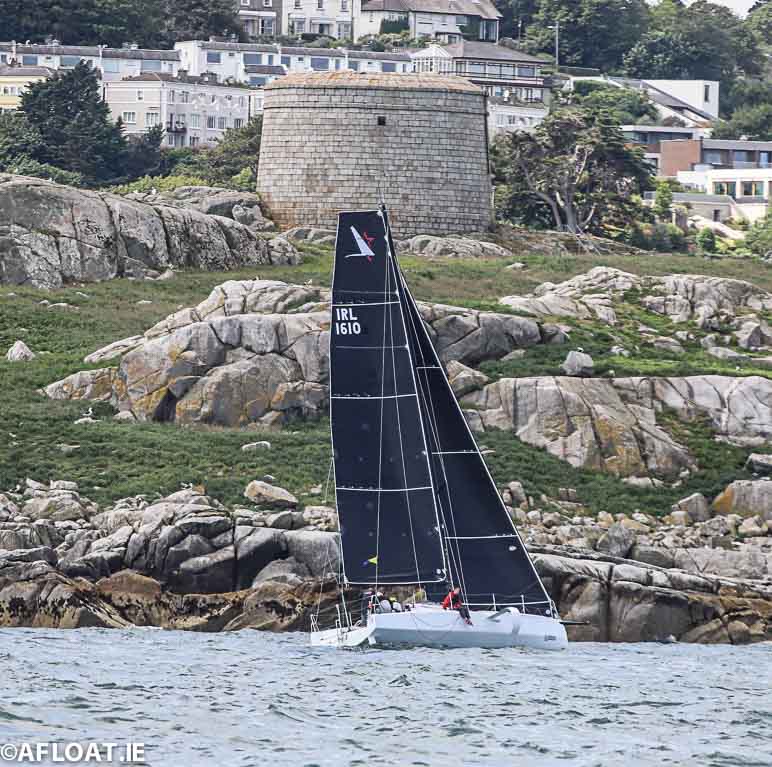 Conor Fogerty's new foiling Figaro 3 Raw Photo: Afloat
Conor Fogerty's new foiling Figaro 3 Raw Photo: Afloat
Competing in the 138-boat Myth of Malham Race this season was the HH42 Ino XXX raced by James Neville who was second on corrected time in the 30-hour race. Sixth overall in the 2017 Fastnet, Ino XXX will find herself competing against the recent third-placed Myth of Malham finisher, the Ker 40 Keronimo raced by Lars & Birgitta Elfverson (SWE).
If the conditions come right for Raw, one of the new foiling Figaro 3 keelboats, then former Irish Sailor of the Year, Conor Fogerty, could be lighting up the Celtic Sea. Fogerty is intent on an Olympic campaign for the new doublehanded offshore event in Marseille 2024, but is sailing four-up for the Fastnet.
Based on sheer experience in the Fastnet, the crew of Lutine from Gosport must be considered as a contender. Neil Armstrong is skippering the X-55 this year, and he's looking forward to the amateur crew showing what can be achieved with a concerted training programme.
Another crew that never misses a Fastnet is Moana, a First 47.7 skippered by François Goubau who races with his wife and three sons. This will be the Belgian boat's 10th Fastnet Race and one of the three sons, Mathieu, will be steering the boat as he has been since the age of 16; this is his 11th Fastnet yet he's still only 38 years old. Over the years Moana has been a RORC race regular, ranging from the Commodores' Cup (second in 2016) to the IRC Nationals and Cowes Week (class winner) and has taken three podium places in class at the Fastnet.
IRC Two
The most likely winner of IRC Two will be Géry Trentesaux, who won the race in a JPK 10.80 in 2015 and won last year's Rolex Middle Race in his present boat, JPK 11.80 Courrier Recommandé.
 Gery Trentesaux's JPK 11.80 Courrier Recommandé Photo: Paul Wyeth
Gery Trentesaux's JPK 11.80 Courrier Recommandé Photo: Paul Wyeth
Having spotted the success of the JPK designs and Trentesaux in particular, Tom Kneen bought a JPK 11.80 last year with a view to winning the Fastnet Race at his third attempt. From a comedy of errors in his first Fastnet just four years ago, the Plymouth businessman has proven a fast learner with his Sunrise crew. "The biggest challenges are the tides between the Solent and Land's End - we have lots of decisions to make," says Kneen, whose team are almost all RORC Under 35 crew and three of whom are members of the RORC Youth Griffin Committee. Additional expertise comes from the young navigator Tom Cheney who works for INEOS Team UK.
Christian Teichmann and Hugh Brayshaw are racing Abu 43 in the doublehanded fleet but could threaten for a division win. Formerly owned by the Artemis Offshore Academy, Abu 43 is an enhanced Figaro II, optimised for racing under IRC. Teichmann, a German investor, is competing in his first Fastnet while this is Brayshaw's second assault on the Rock. Young, but with a wealth of offshore experience, Brayshaw is optimistic about their chances. "I think this time racing shorthanded will mean the latter stages of the race could be hard. But last time we rounded the Rock with a clear sunrise and all these boats around us. We are hoping to finish amongst the top of the Figaro IIs, however, if conditions are right then we could see ourselves towards the front of our class and two-handed."
Another double hander worth watching in IRC Two is Ajeto!, a J/122 sailed by joint owner-skippers, Robin Verhoef and John van der Starre from the Netherlands. The engineer and dentist from The Hague have been Dutch IRC champions four times, and were European J/111 champions in 2015 with a previous boat, Xcentric Ripper, with which they won class in the 2015 Fastnet. It's the fourth Fastnet for another J/122, Junique Raymarine Sailing Team, specially adapted for shorthanded sailing and a proven performer in the hands of Chris Revelman and Pascal Bakker who took 3rd in class at the 2018 Round Britain and Ireland race.
The First 40 and First 40.7s will be out in force for IRC Two but whether any can threaten the more optimised boats in this division is another matter. The First 40, Sailplane, is owned by Rob Bottomley and skippered by Nick Martin, and will be hosting Catherine Keohane and her friends and family. It will be Keohane's second Fastnet and this time she is driving a more competitive entry. "We decided to choose the crew and the boat to be more competitive. It is a challenging race attracting a world-class fleet from around the world and it gives us a 'kick' to be taking part alongside professional and amateur sailors alike." With seven out of the 10 crew having completed one or more Fastnets, this is an experienced Corinthian crew.
Fastnet ’79: A Personal Recollection Of A Terrible Night From Skipper & Crew Of ‘Flicka’
Unseasonable gales in August have little meaning for those who experienced a terrible night that month in 1979, on the third day of that year’s Fastnet Race, as the skipper and crew of Flicka recall.
The morning after the hurricane hit, it was the lead story around the world. For a small group of Schull Harbour Sailing Club members, it was just a lucky escape.
In Schull that afternoon, fellow sailors and newsmen armed with cameras and seasick pills were going to watch the Fastnet Race frontrunners round the rock.
Michael Murphy — our skipper — and wife Derval, together with Mick Barnett, Steve Cone and the Collins girls were keen to go.
Frank Boland had offered them the use of his 36ft heavy displacement motor cruiser Flicka, and suggested that the two older members of his family, Mary and John, would come along. They headed for sea with a picnic, a bottle of grog for the crew — and a warning to be careful from harbour master Jimmy Reilly.
As Flicka nosed into the bay, the other boats were returning. Past Long Island, the swell deepened and the boat bounced to the Fastnet Rock. A feast was consumed on board, and as the cruiser hung around, head to wind off the lighthouse, dusk descended, with the onset of heavy rain and an ever increasing wind. In hindsight it was fortunate there was no marine radio on board, as to the east the horror of the night was beginning.
Many years later, while attending a book launch for The Lightkeeper, author Gerald Butler confirmed that he was on duty on the Fastnet that night and was trying to contact Flicka on the VHF, and eventually when he lost sight of her navigation lights he called Baltimore lifeboat, which immediately launched, but was then diverted to the Irish yacht, Ken Rohan’s Regardless which was in serious danger, having lost her steering off the Staggs.
In hindsight it was fortunate there was no marine radio on board, as to the east the horror of the night was beginning
The mystery of the boat described in his book was all the more intriguing when he discovered that the owner, Frank Boland, was one of the Commissioners of Irish Lights who had overall responsibility for the operation of the Fastnet.
Having turned for home, the full force of the storm hit — together with the realisation of the vessel’s unsuitability for the weather, with the following sea in danger of swamping the boat.
The sing-song provided a little comfort, while all eyes peered through the darkness as the nearer to Schull they motored, the more serious the situation became.
In the harbour, the wind was beyond gale force and appeared cyclonic in direction, hitting the hull from all angles. The raindrops were like thimbles flying upwards into a night that was as black as a witch’s hat. Shapes whirled in the water and lights faded in and out as the screen wipers thwacked.
Through prisms of water, Steve Cone on the bow pointed out the lights of a yacht battling its way up Long Island Sound, which subsequently turned out to be Ted Crosbie, who hugged the island shore for shelter all night. Steve’s face, lit by the bow navigation lights that matched his green oilskins, made him look like the Incredible Hulk.
With Schull pier underwater and a chaotic scene developing for the yachts lining the pier wall, it was decided to try for Flicka’s moorings. Here, Mary Boland played her ace card, managing to locate the mooring buoys. Mick Barnett and Steve managed to hook it at the first attempt, but were unable to hold on when struck by a particularly powerful gust, losing the only boathook on board. A quick search located a hooked-on boarding ladder with which Steve, lying over the bow, managed to secure the mooring, while Mick Barnett held onto his legs for dear life.
Shapes whirled in the water and lights faded in and out as the screen wipers thwacked
For Flicka’s crew, the danger was increasing. Disembarkation was to be a nightmare. Spouse was separated from spouse, sibling from sibling; if the worst happened, no family would endure a double tragedy.
Boarding the rubber dinghy was like riding a panicking porpoise and every yard travelled shipped a gallon of water. Three seemingly endless journeys landed everyone back to the pier, where the rafted yachts were splintering together while one leg of Peter Jay’s catamaran lay like a beached whale on the head of the pier.
The last to abandon Flicka was Michael Murphy, with Mick Barnett helming the dinghy. On shore, everyone tried to track them in the impenetrable darkness. Lamps were waved back and forth and names called … no sign. The only noise above the wind was the sound of children crying on the rafted yachts.
A horror began to insinuate itself into the minds of the watchers. As their senses verged on the possibility of loss, familiar voices suddenly boomed from the darkness. The little outboard engine had finally given up the ghost and the dinghy had been driven into the shingle beach in the Acres. The short walk, the hugs and laughter brought blessed relief.
The wind dropped off gradually about 4am and as the early dawn rose, both sailors and fisherman met in the metallic light to witness the havoc, only then to learn the fate of those who had encountered the demon in the night.
Patrick O’Reilly has also shared his memories of that fateful night in August 1979:
I was a 10-year-old with my late father, Barry O’Reilly — ex-Dragon sailor and ex-Tritsch-Trasch of Howth — as well as Dr Maurice O’Keeffe, Arabella O’Keeffe and Morgan Sheehy, all of Kinsale, when we left Schull Harbour on August 13th, 1979. We were on Flor O’Dowd’s beautiful 35ft ketch, with Maurice O’Keeffe at the helm.
All day, the sea state at the Fastnet was oily and sloppy. Sitting around at the Fastnet for the day caused almost all of us sea sickness which, as I remember, was fully cured by Campbell’s tomato soup and white sliced pan from O’Dowd’s bakery in Kinsale.
We saw both Ted Turner’s Tenacious and Bob Bell’s Condor round the Fastnet. My 10-year-old self definitely got a triumphal wave from Turner, the ‘mouth of the south’.
I remember well the change in weather around dusk. We surfed the following sea to the mouth of Schull Harbour. We must have got in to the harbour earlier than Flicka as we did not have the same screaming wind that they had and got ashore without incident.
That night we stayed in the East End Hotel. The hotel had the VHF wired to a tannoy, which broascast the drama of Ted Crosbie (was he sailing a Sadlier?) in Long Island Sound and indeed that of others. It was both real and surreal at the same time...
Eight Irish Boats for August's Fastnet Race from Cowes
August 3rd's Rolex Fastnet Race from Cowes is shaping up to have more Irish interest than the landmark turning point with eight Irish-flagged boats in the 26-nation race and Irish sailors also registered as competing on boats across the record fleet.
As Afloat reported earlier, this is a significant year, not only for the record 400-boat fleet taking part in the world's biggest offshore race but it marks the 40th anniversary of the 1979 race.
As well as Conor Fogerty's foiling Figaro 3 Raw, from Howth and Keith Miller's Andante, a Yamaha 36 from Wexford, boats with Irish flags include the much campaigned Dehler 34 Big Deal by father and Son duo Derek and Conor Dillon from Foynes Yacht Club.
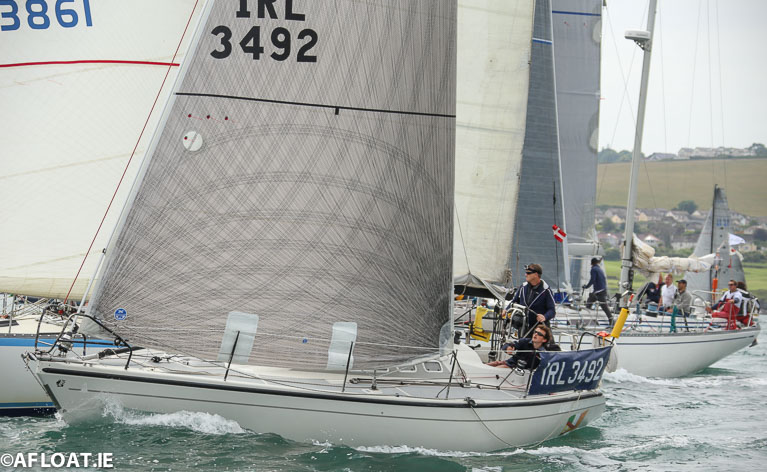 Derek and Conor Dillon's Dehler 34 Big Deal from Foynes Yacht Club Photo: Afloat
Derek and Conor Dillon's Dehler 34 Big Deal from Foynes Yacht Club Photo: Afloat
Ronan O'Siochru's Dun Laoghaire Marina-based Irish Offshore Sailing School will have two entries Desert Star and Sherkin, both Sunfast 37s.
 Ronan O Siuchru from Irish Offshore Sailing Photo: Afloat
Ronan O Siuchru from Irish Offshore Sailing Photo: Afloat
 Irish Offshore Sailing School will have two Sunfast 37s racing. Photo: Afloat
Irish Offshore Sailing School will have two Sunfast 37s racing. Photo: Afloat
Cian McCarthy's Eos from Kinsale, James Crockatt's Irish-flagged A35 Jump 'n' Shout and Brendan Coghlan's Dun Laoghaire-based Sunfast 3600 YoYo.
 Brendan Coghlan's Sunfast 3600 YoYo Photo: Afloat
Brendan Coghlan's Sunfast 3600 YoYo Photo: Afloat
As Afloat previously reported, a special service at Holy Trinity, Cowes will be held the night before the race.
Irish Sailors in the Fastnet Race
Irish sailors are also competing on the following boats (from the crew lists so far): Venomous, Mardy Gras, Polished Manx II, Catzero, Simples, Lucky, Rho, Galahad of Cowes, Finnish Line, Lutine, Juno, Andante, Sunset, Eos, Rock Lobster, Yoyo, Jengu, Alcibiades III, Rum N Cork II and Jackhammer.
 The Welsh ISORA competitor Jackhammer will have Irish crew onboard for the Fastnet Race Photo: Afloat
The Welsh ISORA competitor Jackhammer will have Irish crew onboard for the Fastnet Race Photo: Afloat
First Fastnet Yacht Race for Irish Farmer
County Wexford suckler and tillage farmer Keith Miller is as at home on the water as he is in the fields. Hailing from the Kilmore Quay Boat Club and with 30 years' service with the Rosslare Harbour Lifeboat, this will be Keith's first time doing the Rolex Fastnet Race although he has competed in the last two editions of the Round Ireland Race. He had only just bought the boat in 2015 when he started planning the first race in 2016, competing with his two daughters.
On the Fastnet: "The preparations alone are quite a challenge", says Keith. "After that, we feel the biggest challenges will be how to make best use of the tides at the headlands along the English south coast. The race has such a legendary history, it is a challenge every sailor dreams of and not for the faint-hearted."
Keith's crew is drawn from other local sailors from Ireland including a fellow lifeboat crewman and station mechanic, a secondary school teacher, a retired teacher, an engineer and his daughter Beth, who at 15 was the youngest Round Ireland Race competitor in 2018.
The atmosphere in Cowes in the days leading up to the start of the Fastnet Race inevitably provides a heightening sense of anticipation and tension writes W M Nixon. And for 2019’s race on Saturday, August 3rd, there is an added intensity of emotion, as it marks the 40th Anniversary of the storm-struck race of 1979 which resulted in a total of 19 deaths.
In solemn acknowledgement of this, and in memory of those lost – some of whose former shipmates will be sailing in this year’s race – a special 40th Anniversary Service will be held the evening before the race in the “Sailors’ Church” in Cowes, Holy Trinity Parish Church, which overlooks the Royal Yacht Squadron starting line from which the Fastnet fleet traditionally starts its race westward.
 The Royal Yacht Squadron in Cowes with Holy Trinity Church beyond
The Royal Yacht Squadron in Cowes with Holy Trinity Church beyond
To be held on Friday, August 2nd at 1800 hrs, the service will be in the church which has the Memorial to those lost in August 1979, while there’s another Memorial Stone on Cape Clear Island, the nearest land to the Fastnet Rock itself.
There will be other memorial ceremonies in Baltimore and West Cork. But it’s highly appropriate that the sequence of remembering and honouring those lost should begin where this fateful event, which they had so keenly anticipated as a great sea adventure, finally got underway in the time-honoured flurry of excitement forty long years ago.
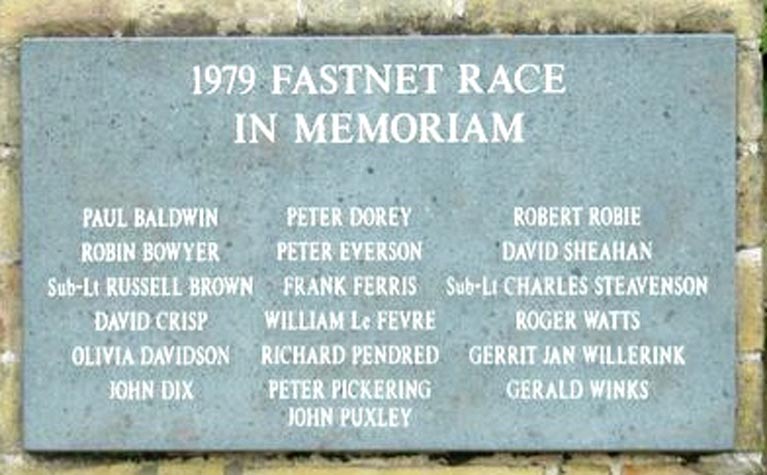 The 1979 Fastnet memorial in Holy Trinity. David Sheahan and Gerald Winks – lost from the Half Tonner Grimalkin – were both originally from Ireland
The 1979 Fastnet memorial in Holy Trinity. David Sheahan and Gerald Winks – lost from the Half Tonner Grimalkin – were both originally from Ireland The Cape Clear Memorial stone is an eloquent reminder that the nearby Fastnet Rock is very much of West Cork
The Cape Clear Memorial stone is an eloquent reminder that the nearby Fastnet Rock is very much of West Cork































